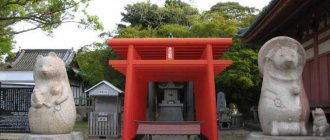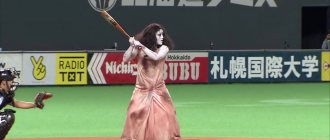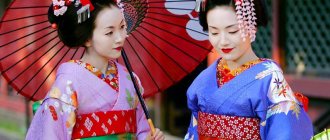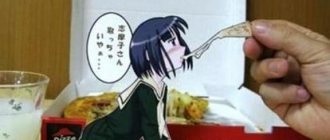Educational process
Start of the school year in spring
The academic year in Japanese schools begins in April and is divided into trimesters: April-July, September-December, January-March. Summer holidays last only a month and a half.
The beginning of the school year in Japan coincides with the cherry blossoms.
Every year in a new class
In Japan, junior, middle and high schools are located in different buildings and are separate educational institutions. Moreover, classrooms there are formed every year in a new way: all students from one parallel are randomly distributed into groups. This shuffling develops in students the ability to easily find a common language with their peers.
No absenteeism
Japanese schoolchildren almost never skip classes. The school attendance rate in this country is close to 100%. Being late is also a rare occurrence for a Japanese school. The teaching profession is highly valued, and therefore the attitude of schoolchildren is corresponding.
Ban on relationships
Dating is prohibited on school grounds. This is done to ensure that students are focused on gaining knowledge.
Homework is not marked
Teachers in Japanese schools do not grade homework or assess students' readiness for class. They circle correctly completed tasks in a red circle, and leave the rest for the future. From time to time, Japanese schoolchildren write tests in all subjects, which are graded on a 100-point scale.
Interesting Facts:
1. In Japan, all desks are single. 2. The door to the classroom is not the same as we are used to seeing; it opens to the side. That is, it moves from right to left. 3. The board is now electronic in schools.
4. In Japan, a number of suicides occur every year due to students failing exams.
5. In Japan there are still schools called gakuen with separate education for boys and girls. They are similar in type to lyceums, and there are special strict canons that children must obey unquestioningly.
6. Vacations for the Japanese are a time when you can thoroughly study. Weekends are spent the same way - completing tasks, and sometimes there is no time to even go outside.
School and education system in Japan from the 500s to the present day.
Japanese school uniform
Views: 5,013
Share link:
- Tweet
- Share posts on Tumblr
- Telegram
- More
- by email
- Seal
Liked this:
Like
Appearance
School uniform
Middle and high school students in Japan are required to wear uniforms. Usually this is a military-style suit for guys and a sailor suit for girls. But there is also a Western variation, which is distinguished by a white shirt, tie and sweater with the school’s coat of arms. School uniform disciplines students, helps them unite and get ready for work.
The boys' school uniform is called "gakuran", the women's - "sailor fuku". It has winter and summer variations
Strict rules regarding appearance
Many Japanese schools have strict rules regarding the appearance of students. It is prohibited to use decorative cosmetics, do piercings, tattoos, dye your hair, or wear provocative accessories. All this distracts from studying.
“My classmates addressed me as “you”
In Japan, no one calls each other by their first names. It is believed that this is a personal space that cannot be violated. The exception is best friends and, perhaps, classmates. The rest are usually called by their last names. At first, my classmates addressed me as “Katya-san.” The Japanese use the suffix “san” in everyday communication; it’s kind of like addressing someone as “you”. I didn't like it, and I asked them not to call me that.
During breaks, we most often talked about boys and relationships. The guys are discussing anime or computer games. Someone is doing homework. In Japan, little is known about Russia. Basically, all their knowledge is vodka, bear, Putin, kokoshnik (which, by the way, they call “Katyusha”). They think that Russia is Moscow and Siberia, and that’s it, nothing more. So I told them about Yekaterinburg and how beautiful it is in the Urals.
|
| Photo booths are popular among Japanese schoolchildren. |
After lessons
Interest clubs
After lessons, Japanese schoolchildren do not rush home, because they enjoy studying in school clubs based on their interests. Most often they come in two directions: sports (basketball, baseball, tennis, kendo, aikido, judo, etc.) and art (music, singing, literature, foreign languages, etc.). Bukatsu - 'classes in a circle, club, section' - is a voluntary initiative, but in fact, every student is involved in interest clubs.
The Japanese are especially sensitive to preserving traditions. Kendo is a modern fencing art designed to strengthen the will and body
TOP 12 facts about Japanese schools that are worth knowing
Are you dissatisfied with the domestic secondary education system? Find out how they study in Japan and what incredible restrictions Japanese children face from early childhood!
Distant Japan never ceases to amaze with its unusual and sometimes even strange traditions. The education system also has its own characteristics, which is radically different from that usual in post-Soviet countries. It will be interesting to find out what would surprise our schoolchildren in Japan.
The school year begins in the spring!
Children start school not in September, but in April. It’s just getting warm, the trees are blooming, you want to take a walk outside, but then you have to take textbooks and go to class - horror! The Japanese school rule that summer holidays last only a month and a half can be a horror story for our children. In winter and spring, their rest is about 10 days. Another fact that is incomprehensible to us is studying on a day off (Saturday). As for the length of the school day, it lasts from approximately 8:30 to 15:00.
No more than two friends per class per year.
We are accustomed to studying in the same group throughout our school life, but this rule is unfamiliar to Japanese students. Every year, all parallel students are randomly assigned to classes, but the student has the opportunity not to part with close friends, and to do this he must write their names (no more than two) in a special questionnaire. Perhaps this helps to get comfortable in society, but it looks strange, to say the least.
Numbered schoolchildren.
The following rule in Japanese schools is somewhat similar to those used in prisons, since each student is assigned an individual four-digit number. It is used for signing works, going to libraries, and so on.
The schedule is a surprise.
Perhaps the developers of the education system in Japan love surprises, since every week in schools students receive a new lesson schedule. It is difficult to predict how our students would react to such updates.
Change? No, we haven't heard.
If you ask our children what you like most about school, the most popular answer will be recess. Japanese schoolchildren are deprived of this pleasure because they study all day and only take one break for lunch. It seems that from childhood the Japanese are prepared for the hardships of adult life.
Have you brushed your teeth? I wrote it down in my diary!
The diary that Japanese children keep is completely different from the one we often forgot at home. In it they record not only their lessons, but also the entire schedule of their day: what time they got up, when they brushed their teeth, and so on. It seems that the children of Japan are under constant control. In general, no personal life.
Who is on duty at the toilet?
If in our schools students only clean their classrooms, and this rule is not used in all educational institutions, then in Japan children have to clean up other rooms, including toilets. Just imagine that after school, schoolchildren will have to wash the floors, windows and more.
There are no losers!
We often went to school with shaking knees without having learned our lesson, worrying about getting a bad grade, but this is not the case for Japanese schoolchildren. It’s very simple: I prepared my homework, it was circled in red, if not, then the debt was assigned. Even in Japan, no one is left for the second year, even if the student lags behind others.
Japanese schoolchildren are easily recognized by the color of their socks.
Schools have strict restrictions regarding appearance. For example, no experiments with hair color, and boys should only wear short hair. It will be surprising for girls that if they studied in Japan, they would not be allowed to wear makeup, paint their nails or wear jewelry. The rules are so strict that management even enforces the color of socks, which must be black, white or dark blue. For our society, this looks like madness.
Quiet hour.
During school lessons, many people thought about kindergarten, or rather about quiet time, because it would be so nice to put away notebooks and textbooks and just take a nap. This privilege is available in Japanese schools, where children have the right to a ten-minute nap on their desks.
Knowledge is power, hieroglyphs are power!
Just imagine, Japanese children must learn to read and write in three ways: Japanese characters, the Japanese version of Chinese characters, and the Latin alphabet. What would definitely please our students is the presence of the Internet at school and the use of modern information technologies in teaching.
Sasumata instead of a poster.
In Japan, schools do not hang posters or educational stands on the wall, but weapons - yes, yes, you heard it right! Near the door in each classroom you can see a sasumata - a Japanese combat grip, with which, if necessary, the teacher can protect children from attack, for example, by a thief.
Bonus fact number 13: Japanese schoolgirls don't wash their panties, they make a living with them!
Many people earned money in various ways as children, for example, helping their mother around the house or walking the neighbor’s dog. Japanese schoolgirls have found a strange way to make money by selling (attention!) their dirty panties. Unfortunately, there are many perverts in the world, and Japan is no exception, so such products are in great demand.
Japanese often go to work right after school
Higher education in Japan is paid. Some of my classmates wanted to go to university in Sapporo, a large city on Hokkaido (the northernmost island). But this is difficult to do, especially if you live in a small town. Therefore, more often than not, after school, the Japanese begin to look for work.
To get a job at a company, you need to go through an interview. Children who decide that they will not go to university begin to prepare for it in advance - in high school. When they come for an interview, they give their serial number, first name, last name, school from which they came, and age. If they like them, the employer conducts a special course for them. After that, they become assistants, but can then be promoted. For a Japanese, career is more important than family. Many even get married for show, so that they are more respected at work.
Continuity is important in Japan. If you are the son of a doctor, then by birthright you are obligated to become a doctor (doctors in Japan earn the most). Parents, of course, will help you get a higher education - most likely at the University of Tokyo. There are, of course, exceptions when children of doctors want to become, for example, writers, but this is usually not approved. There are entire families who perform in kabuki theaters. This is another profession that is inherited in Japan. It is considered very prestigious, so boys study in private, elite schools from childhood.
You can find out how to become an AFS student on the organization’s official website.
For international students
The level of education in Japan is very high. It is not surprising that many foreign citizens want to study in this country. There are two options for them:
- A full course of university education lasting four to six years. Its cost ranges from 6 to 9 thousand US dollars. The approach to passing the entrance exams is very strict, plus knowledge of the Japanese language is required.
- A short-term course of higher education, lasting two years. It costs much less and requires knowledge of English.
To obtain postgraduate education, you must have your existing diploma apostilled before presenting it in Japan. Since this country is a party to the Hague Convention, an apostille can be used rather than legalization.
Regardless of the country, all students are provided with the same opportunities in obtaining higher education. Naturally, you need to successfully pass exams and pay tuition fees.
Three stages in training
This is what the Japanese school education system consists of. Among them:
- The first stage is primary school with a duration of study of 6 years.
- The second level is secondary school, where students study for 3 years.
- The third stage is high school, where students study for 3 years.
The first two stages - primary and secondary schools - are strictly compulsory, and the third is optional. But despite high school being optional, the completion rate among Japanese students is close to 96.
School program
The teaching program varies from school to school, but is based on standards approved by the Ministry of Education. Responsibility for funding, teacher staffing and the school curriculum lies with local authorities.
In Japan, children begin to attend school when they reach the age of six. Before this, children usually go to kindergarten. By the time they enter school, children should have basic arithmetic and be able to read hiragana and katakana.
In elementary school, children study Japanese, mathematics, science (physics, chemistry, biology), social studies (ethics, history, etiquette), music, fine arts, physical education and home economics. By the end of primary school, children must, in particular, learn 1006 Kanji characters from the 1945 characters on the state list.
In secondary school, English and several special elective subjects are added to the list of subjects. The composition of these subjects depends on the school.
The most difficult subjects are mathematics and languages - Japanese (learning kanji) and English.
The high school curriculum is slightly more varied than the middle and primary school curriculum, but students are given more opportunities to specialize in a particular area of study.
Relationships in the team
Japanese kindergartens have fairly small groups, ranging from six to eight people. Their composition is reorganized every six months. This is due to providing children with greater opportunities for socialization. A child may not have good relationships in a group, but he may find friends in another. Teachers are also changed all the time so that the children do not get too used to them. It is believed that in this way the students become dependent on their mentors.
In Japan, they prefer not to compare children with each other. The teacher never singles out the best, and he never scolds the worst. Parents are also not told that their child is the best runner or draws poorly. It is not customary in Japan to single out anyone. Even in sporting events there is no competition. Either friendship or one of the teams always wins. "Don't stand out!" - this is the most important principle of Japanese life and the Japanese system of education and upbringing.










